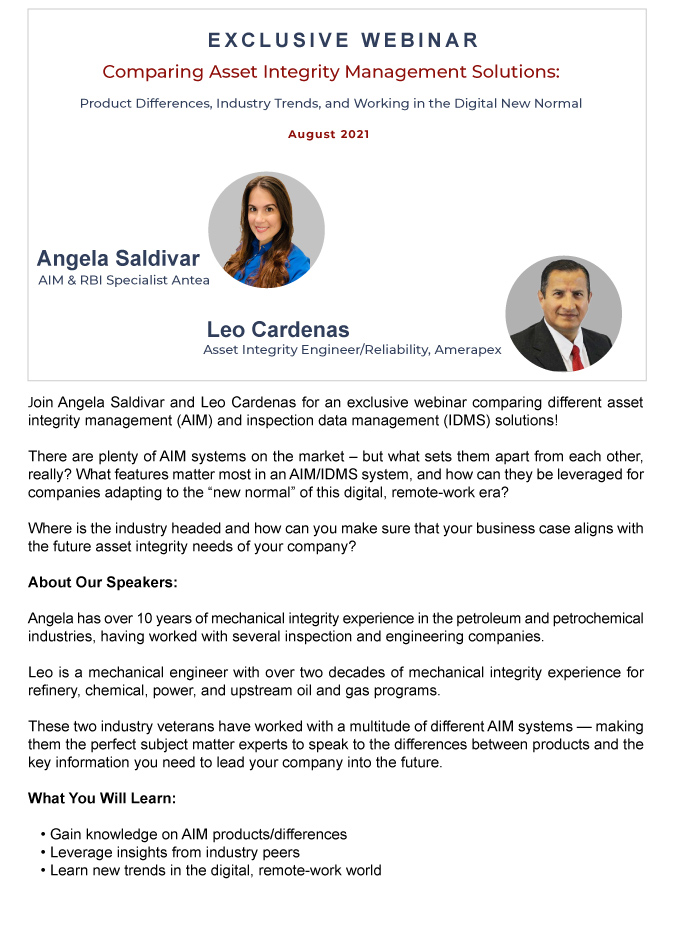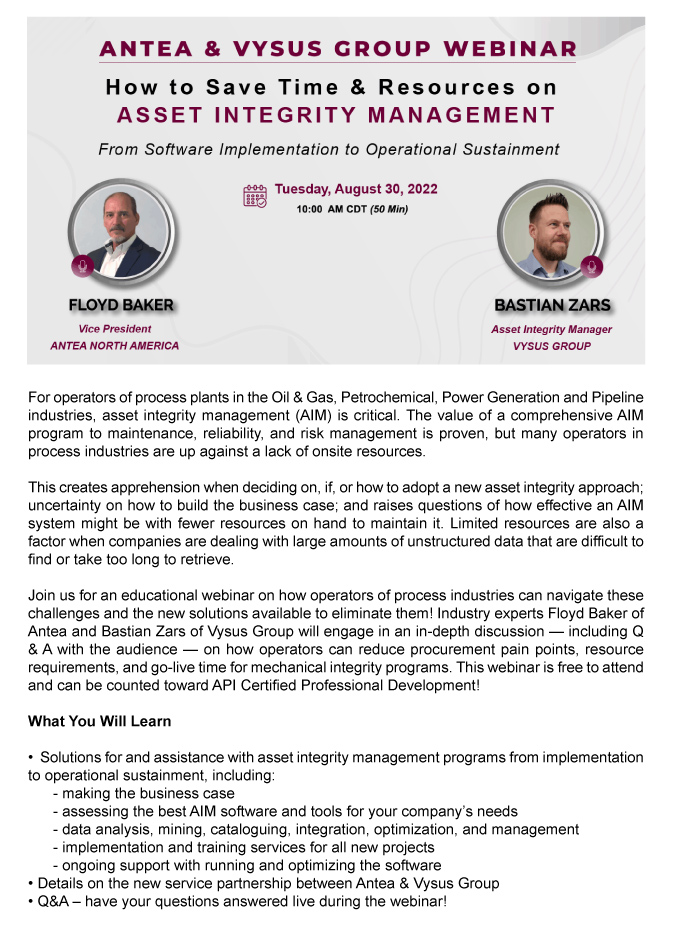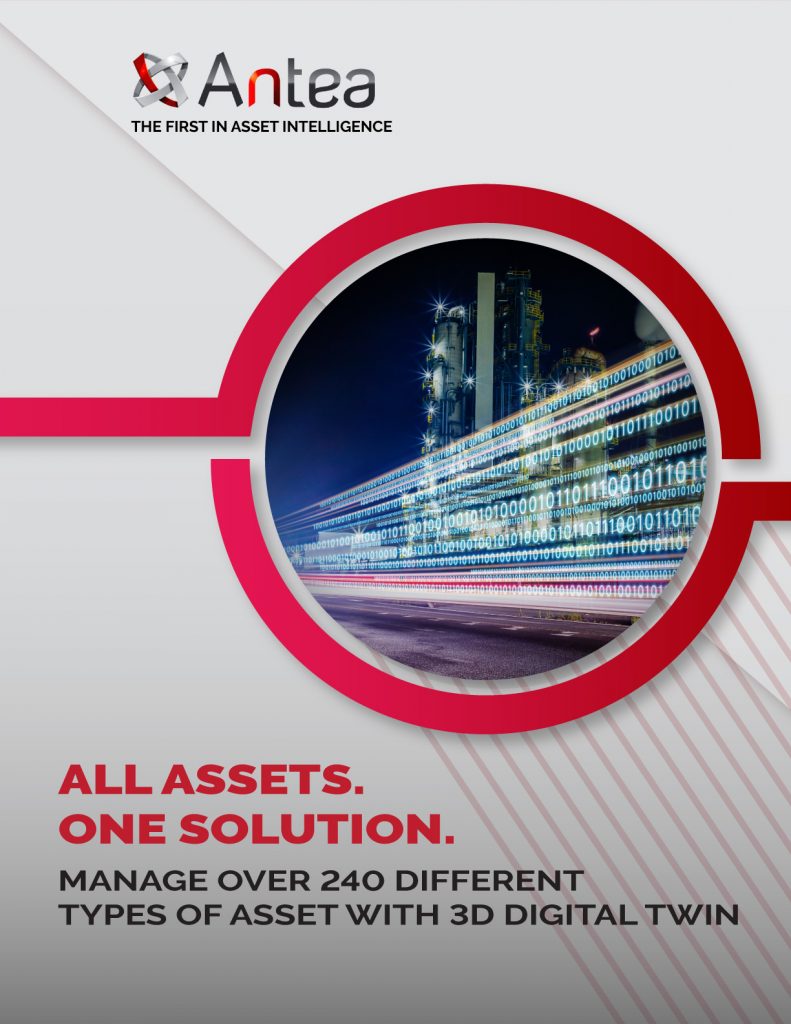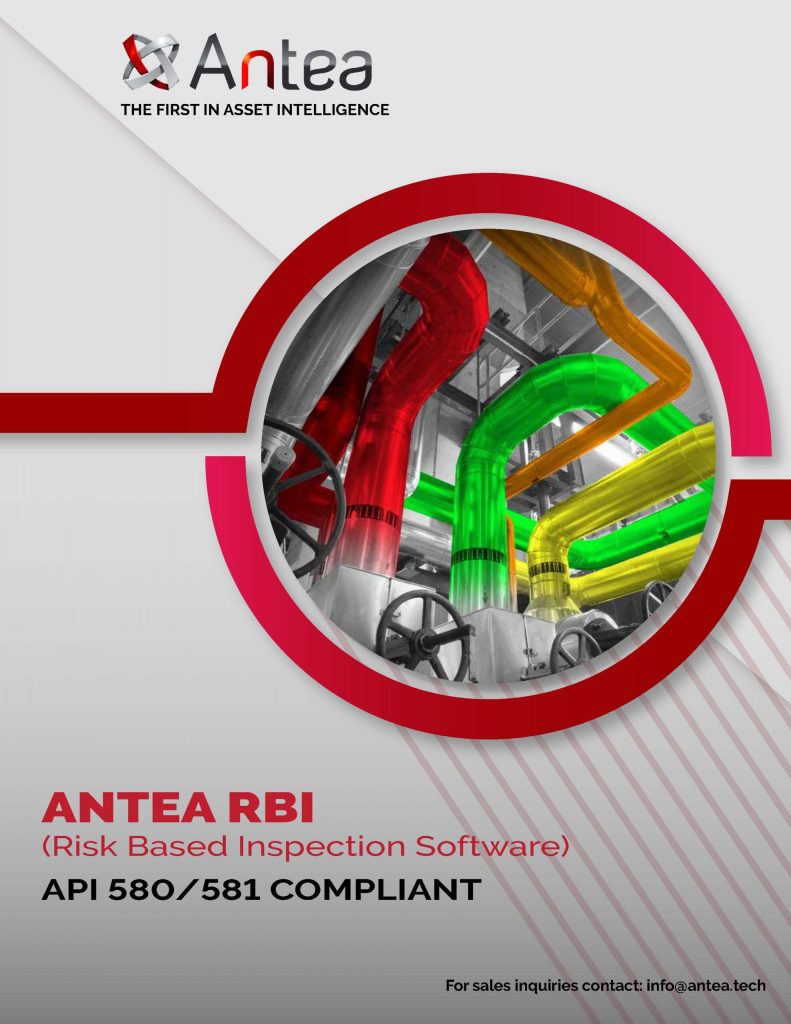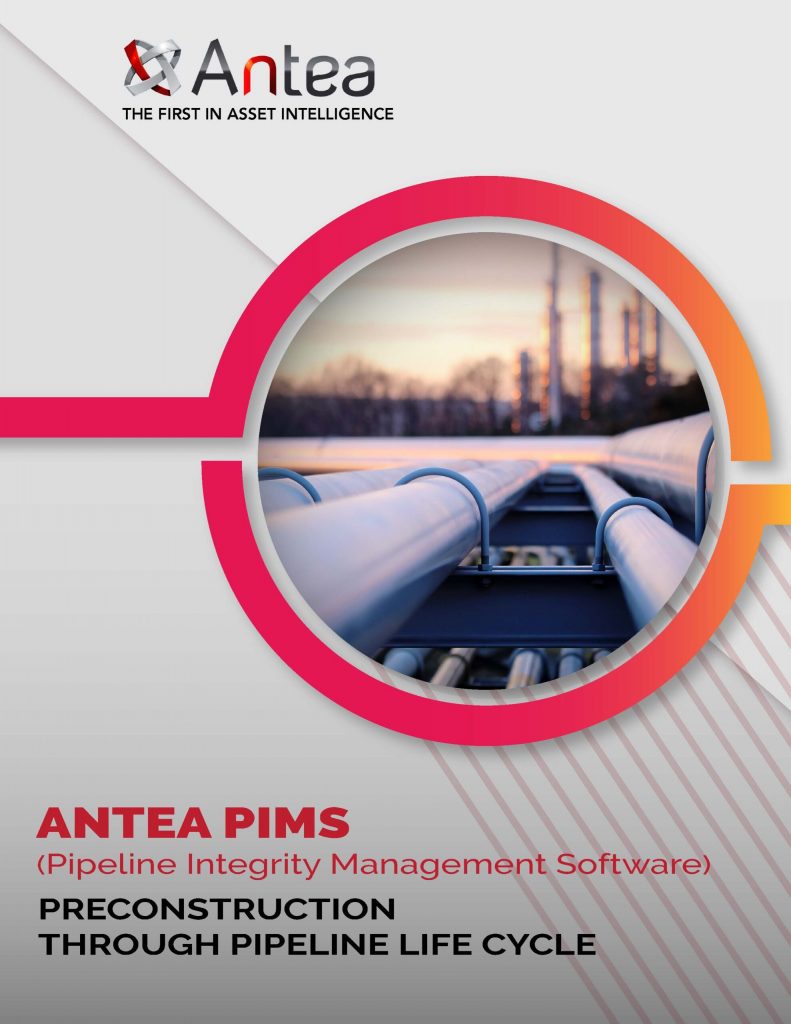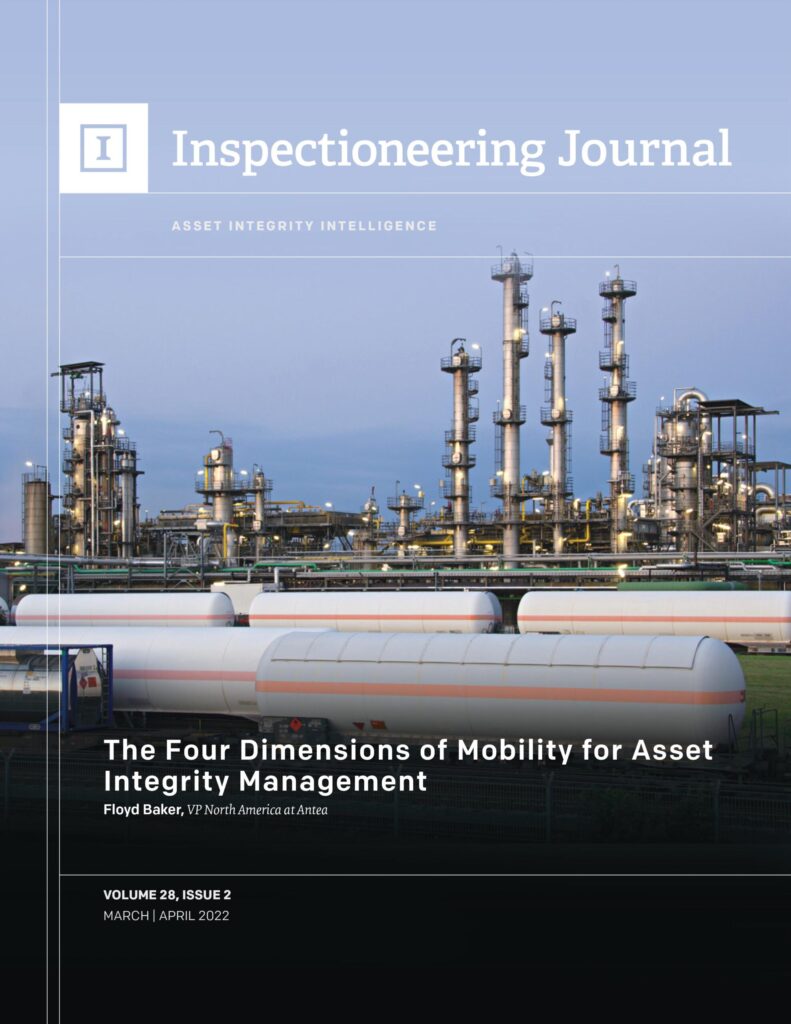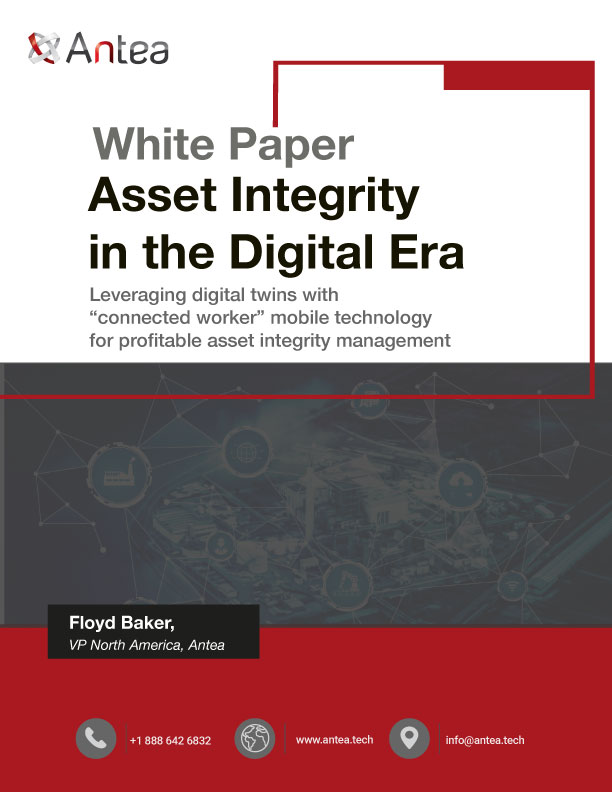
Digital transformation. In today’s rapidly evolving digital era, the concept of digital transformation for asset-intensive plants and facilities is no longer just a novel concept – it is a necessity. The Industrial Internet of Things (IIoT) has revolutionized the way we approach asset integrity management (AIM), transforming operational efficiency and the actionable intelligence operators can glean from their assets.
Digital transformation refers to the digitalization of plant data, workflows, and processes – moving away from old methods of paper-based reporting and time-based inspection, and into an era where asset data can be immediately accessed in real-time for smarter inspection and maintenance planning. However, digital transformation is not a one-time event. It isn’t simply a product that can be purchased and instantly implemented. Rather, it is a journey; a journey that is unique to each company that embarks on it, according to the type of equipment they have and whether any level of digitalization yet exists at the facilities. Therefore, each operator will set out on the journey to digital transformation from a different starting point, and each will require different implementation strategies to reach the end goal.
Over the coming weeks, the Digital Transformation Series of the Antea Blog will closely examine different digital strategies that operators can leverage to formulate a journey map for digital transformation at their own facilities. The series will include articles on:
- The Role of IIoT for Asset Integrity Management
- Digital Twin
- “Big Data” and Predictive Data Analytics
- Cybersecurity
- Workforce Enablement
- “Connected Worker” for Remote Collaboration and Hands-Free Inspections
- Scalable Implementation Strategies
This week, we’re looking at the role of IIoT for AIM and how it enables digital transformation by being the driver to connect all digital strategies into one definitive journey map.
IIoT for Asset Integrity: Creating a Single Source of the Truth (SSoT)
The evolution of digital technology has transformed the landscape of maintenance and operations for plants and facilities in asset-intensive industries such as oil and gas, petrochemical, power generation, and even pharmaceutical – bringing with it unprecedented opportunities to improve operational efficiency. No matter what industry you’re in, the critical components of AIM are universal: gather as much actionable intelligence about the health and longevity of your assets as possible to adopt predictive maintenance – improving safety, reliability, and environmental impact while optimizing operational profitability.
IIoT makes it possible to interconnect physical assets and the methods of data capture on them like never before. For these industries, IIoT refers to interconnected sensors, instruments, and other devices networked together with computers’ industrial applications. It is essentially the convergence of all data points into one single source of the truth – one digital database that is current and evergreen, continuously updated with real-time data received from multiple sources about the equipment. The single source is an AIM software or platform, which exists by design to centralize all integrity information on industrial equipment. IIoT enhances AIM’s ability to do that.
IIoT refers to the interconnectivity of sensors, instruments, and other devices networked together in a single platform. The most important value found in IIoT is in the connection. It is the heart and driver of digital transformation for mechanical integrity. Because of it, new technologies can be leveraged as part of a company’s digital strategy map (which we will examine in future posts of this series). Without it, technologies are far less useful; they exist separately, without interconnectivity – limiting the accuracy and efficacy of information that can be gleaned from them. For example: A digital twin is, in concept, still an incredible advancement for AIM – as are remote sensors for live readings about an asset’s temperature, flow rate, pressure, corrosion status. Yet, the real value of these technologies comes in their convergence — connecting them together into one complete story, one single source of the truth of an asset’s current conditions and history.
How does it work?
IIoT begins with digital asset data. To truly maximize the connectivity of data capture sources, the first step is to ensure that they are digitized. In the earlier days of mechanical integrity (MI) programs, reports were managed with paper and pen and inspections were scheduled on time-based intervals. In many facilities, that might still be the case. However, capturing data in disparate files, paper reports, or even Excel spreadsheets does a disservice to maintenance and operations.
It becomes easier to lose sight of version control and accuracy of information, while also making it significantly more difficult to retrieve the information one needs to make decisions. Thus, the first step of any digital transformation journey – and in being able to utilize the power of IIoT – is converting data sources to a digital format. AIM software is an incredibly useful tool for achieving this.
Once all sources of data capture are digitized, IIoT becomes the driver to connect them – and AIM software becomes the vehicle. With IIoT, AIM software can completely bridge the gap between informational technology (IT) and operational technology (OT), connecting them all in a collaborative database from which all departments can view the same information. Better yet, it can be accessed remotely, in real-time, and in many cases, with one click.
Let’s take a closer look at bridging that gap – what is commonly referred to as IT/OT convergence.
- For mechanical integrity programs, IT refers to resource and financial planning within plants and facilities. This includes Enterprise Resource Planning (ERP), Computerized Maintenance Management Systems (CMMS), Enterprise Asset Management (EAM), CAD drawings, Excel, and so on. It can also include things like document management systems or other legacy systems used to provide infrastructure for information.
- OT refers to the edge environment: the asset itself, devices and humans that interact with the physical asset, and processes like inspections, tests, and maintenance activity. Essentially, all operational data received directly from the plant, through systems like distributed control systems (DCS), programmable logic controllers (PLC), SCADA, Data Historian, and remote sensors. It includes data coming from the asset about its health and current condition: pressures, temperatures, flows, PH levels, etc.
IIoT makes it possible to integrate all these data sources and facets of operations into one centralized database (AIM software). This helps you automate procedures, improve processes and workflows, enhance Big Data analytics, reduce shutdowns, and improve profitability. It also eliminates information silos by creating a collaborative environment where all departments can access the same source of truth on the equipment within a facility.
How does this improve MI?
- Proactive and Preventive Maintenance. IIoT allows operators to shift from reactive maintenance strategies to proactive and even preventive ones. Sensors and devices mounted to the assets – either temporarily or permanently, above or under insulation – continuously monitor key parameters and performance indicators on an asset’s conditions. These include temperature, pressure, flow rate, vibration, corrosion indicators, moisture, and so on, delivering real-time data on asset health. This in turn reduces unplanned downtime and makes it possible to optimize maintenance and inspection schedules. Ultimately, it plays a significant role in prolonging an asset’s lifecycle.
- Enhanced Safety. By monitoring critical safety parameters and receiving early warnings or notifications of any issues that might be occurring (especially with Integrity Operating Windows for API 584), IIoT promotes a safer work environment. With the type of sensors used in Digital Twin 2.0, a combination of sensors and optical gas imaging and computer vision can even detect anomalies, leaks, quantify gas emissions, and monitor tank levels.
- Asset Tracking and Optimization. Accurately track assets and ensure accurate inventory management. Mobile asset tracker apps now exist that make this process as simple as scanning a QR code to instantly retrieve all relevant data.
- Time to Find (TTF) Data. Converging all data points into one spot exponentially increases the speed and ease with which one can locate data on an asset. Rather than searching through multiple file cabinets or running to different departments to pull data, with a faint hope that what you finally retrieve is accurate, IIoT makes it possible to instantly find relevant documentation with one click. Instead of days or hours, it can take seconds. In fact, users report an annual average cost savings from TTF of $1.8 million per year.
- Smarter Decision Making. When operators have real-time actionable insights, it enables data-driven decision making. By analyzing historical and current data, it becomes possible to identify trends and more efficiently make informed decisions less vulnerable to error.
- Regulatory Compliance. The interconnectivity of IIoT means that all data required for regulatory reporting is immediately accessible, and with AIM software, can even be automatically generated according to the specific regulations. This helps companies remain audit-ready, reducing unplanned downtime, insurance costs, and overall liability.
The benefits of IIoT for AIM are numerous and become more evident as we examine the specific digital strategies companies can leverage as a result of it. In the coming weeks, we will examine a series of strategies made possible by this digital era, and examine ways that they can be implemented in stages. Scalable and cost-effective implementation from whatever starting point your specific company might be on.
Digital transformation is revolutionary. It is critical. Most importantly, it is a journey. With the right road map in place, it is also achievable.
Stay tuned for our next installment in this series, where we take a closer look at Digital Twin. Don’t want to miss an update? Follow us on LinkedIn.
Additional Resources
For more information on IIoT-enabled AIM software, click here.
To learn about scalable implementation strategies for digital transformation to improve regulatory compliance, download our eBook: Owner Operator’s Guide to Digital Transformation
About the Author
Floyd Baker is executive-level asset integrity management (AIM) and digital strategies advisor and technology driver who specializes in helping operators of asset-intensive plants and facilities achieve digital transformation. An executive with over 40 years of experience, Floyd provides valuable insight and perspective on industrial internet of things (IIoT) technologies for risk based inspection (RBI), asset integrity management, and digital twin — and is a global keynote speaker on these topics.
After starting his career at the ground level, Floyd fulfilled a variety of roles throughout his career — technician, to Chief Inspector, to Executive – all spent dedicated in the field of mechanical integrity, RBI and AIM. His educational background is focused on emerging technologies in inspection, mechanical engineering, and materials science.

